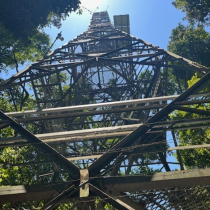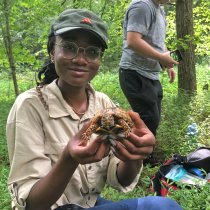Case Study
AGU-TEX Project Update: Monitoring Blue Oaks in the Sierra Foothills
January 11, 2023
Blue oaks are a keystone species in the woodlands of central California; however, temperature change and land management practices have threatened populations in many areas. NEON's Sokaina Alkhafaji partnered with the Sierra Foothill Conservancy and the University of California Cooperative Extension to develop blue oak monitoring protocols that could be used by landowners and conservation organizations across the state. Better blue oak monitoring could help to answer critical questions around land management, temperature impacts, and blue oak preservation.
Grazing Patterns and Blue Oak Regeneration
Blue oaks—sometimes called mountain oaks or iron oaks—are endemic to California, found primarily in the foothills of the Sierra Nevada and Coast Ranges. Stately and slow-growing, they can reach 50-80 feet tall. Rebecca Ozeran, the Livestock and Natural Resource Advisor for the University of California Cooperative Extension (UCCE) for Fresno and Madera counties, says, "The blue oak is a critical component of native species habitat. It's also valuable for landowners. People love them for their aesthetics, and ranchers value them for the shade they provide for livestock and other benefits."
Billy Freeman, the Rangeland Manager for the Sierra Foothill Conservancy (SFC), adds, "Another benefit is that oaks do a lot of recycling of nutrients and moisture from deeper layers in the soil, which increases overall rangeland health and productivity of the understory grasses." In addition to their benefits for ranchers, blue oaks provide numerous other ecosystem services, including carbon sequestration, soil water retention, and wildlife habitat.
Blue oaks are a good indicator of overall ecosystem health in this part of California. Unfortunately, the trees are in trouble in many areas. Blue oak die-offs and low levels of regeneration have raised concerns for ecologists, ranchers, and landowners. Drought has most likely played a significant role in blue oak die-offs, but land management practices also have a strong impact on oak populations, especially on seedling regeneration. Cattle like to graze on young oak seedlings, which impacts seedling and sapling persistence. However, there has been little available research on which land management and grazing practices are most beneficial for blue oak populations.
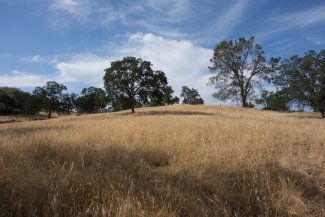
Tall grass landscape at SJER
Sokaina Alkhafaji, a NEON Senior Technician for Domain 17 (California), worked with Freeman and Ozeran as part of an American Geophysical Union (AGU) Thriving Earth Exchange (TEX) fellowship. (Alkhafaji is continuing this project from Erin Crandall – previous TEX fellow.) SFC is a non-profit land trust; in addition to direct conservation efforts, they provide land management advice to local landowners. Freeman is interested in gathering quantitative evidence on how different grazing practices impact blue oak populations at the McKenzie Table Mountain Preserve. He connected with Ozeran at UCCE, who was also conducting blue oak monitoring projects on land adjacent to the NEON San Joaquin Experimental Range (SJER) field site. SFC and UCCE saw an opportunity to work with the NEON program to establish monitoring protocols that could be used across both of their sites.
NEON already had an established blue oak monitoring protocol in use at SJER and other D17 sites, which includes elements such as phenology, canopy fullness, growth (using Dendrometer bands), regeneration, and mortality. UCCE also had some established monitoring protocols of their own. Alkhafaji worked with Ozeran to unify the protocols and develop methods that SFC could implement for their studies. Ozeran says, "The NEON protocol has been integral because it has helped to inform our protocols, even though we are looking at some different things at our site. This is the first time I'm doing a project with oaks, so having people like Sokaina, who are experts in biological monitoring for these keystone species, was really valuable for me. It's also great that our site is within the NEON flux tower footprint, so we can leverage that data as well. Overall, NEON has been very helpful."
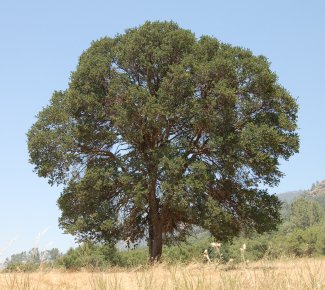
A large blue oak tree near Mariposa, California. Source: Wikimedia Commons
Freeman used the protocols established by NEON and UCCE for a study of blue oaks on two plots at McKenzie Table Mountain Reserve with radically different grazing protocols. One plot is used for High Density-Short Duration (HDSD) grazing once or twice per year, when large groups of cattle are held for a short time prior to shipping. The second plot was used for continuous seasonal grazing, typically from November through May. The study will continue through the spring of 2023, but initial results suggest that HDSD grazing at specific times of the year has a less detrimental impact than continuous seasonal grazing does on blue oak populations, and in particular on seedling regeneration and sapling persistence. Freeman presented his initial findings at a poster session at the California Oak Symposium in November 2022.
The results of the research conducted at SFC and UCCE will lead to better management guidelines for ranchers and landowners. SFC is planning to host a Field Day for landowners and conservationists in May 2023 to present the results of their research and discuss implications for the preservation of blue oak landscapes. They will also share the monitoring protocols. Freeman says, "It will be good to be able to compare our results with results from NEON and UCCE, and eventually at other sites, too. We want to be able to monitor the health of our own little population and be able to compare with other sites locally and regionally. And then, of course, to be able to see their status over time, where blue oaks are thriving and where they are being degraded, and see how different management practices impact that."
Ozeran says that her organization is getting a lot of interest from landowners and state and county organizations interested in blue oak preservation. She envisions a statewide network of blue oak monitoring sites incorporating protocols informed by the NEON program. She says, "From an academic and research perspective, NEON has been a really fantastic partner. Organizations across the country could benefit from having this subject matter expertise. I've learned a lot from Sokaina and others at NEON that will enhance the research we are doing moving forward."
Reflecting on the TEX Experience
Sokaina Alkhafaji joined the NEON program in 2021 as a Lead Botanist and Field Ecologist for Domain 17. She currently works as an Aquatic Field Ecologist for NEON. Her background is in environmental science, including marine science, plant biology, habitat restoration, and environmental education.
What did you hope to gain from participating in the TEX Community Science Fellowship program? Were your personal needs met through the program?
Through the TEX program, I really hoped to improve my professional skills, such as networking and project management. Reaching out to local organizations, collaborating to develop a project that would meet the needs of the community, and continuously monitoring the project data allowed me to meet my personal goals.
What skills, lessons, or approaches from this experience have (or will) you apply professionally and academically beyond this program?
Collaborating with multiple organizations allowed me to expand my networking and communication skills. Contacting local organizations, finding out what resources they need, and being able to provide that information enabled me to sharpen these skills and recognize how to apply them to future projects.
Did the program help build capacity for local engagement within your Domain?
Definitely. With the TEX program, we were not only able to connect with one local organization, but two. Collaborating with the Sierra Foothill Conservancy and University of California Cooperative Extension in Fresno opened the door to bigger projects, even possibly expanding outside of the Fresno area to more of California.
In what ways did your project prioritize and support local community needs?
Rangelands in the California Central Valley are abundant, and many landowners and managers wish to conserve blue oaks for the benefits they provide, but there is a lack of research and technical advice available on implementing beneficial grazing strategies and best practices for promoting healthy ecosystem function. With this project, we can provide those practices.
What were or will be the outcomes of your project? What are your hopes for the community/project you matched with?
The main outcomes for this project include setting up the framework for blue oak monitoring that can be expanded and implemented at most rangelands, as well as using that data to analyze and find best practices for land management. SFC, NEON, and UCCE will host a field day for local landowners, natural resource managers, agency personnel, livestock producers, university students, SFC members, and other non-profit and NGO stakeholders. Furthering stakeholder education on enhancement of blue oak woodlands can impact the bottom line of livestock producers, accomplish ecological objectives of resource managers, and enable all land managers to provide ecosystem services and resilience to change.
Coming out of the program, what are your reflections on community science more broadly?
I see a huge need for science resources to be more readily available for local communities. So many organizations and educational institutions are looking for community science partners to actively work with and are more than willing to share their resources and findings that will impact future research. TEX is only one of the wonderful ways we are able to cultivate community science needs.
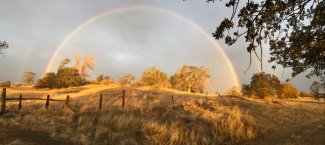
Rainbow over a field in SJER

